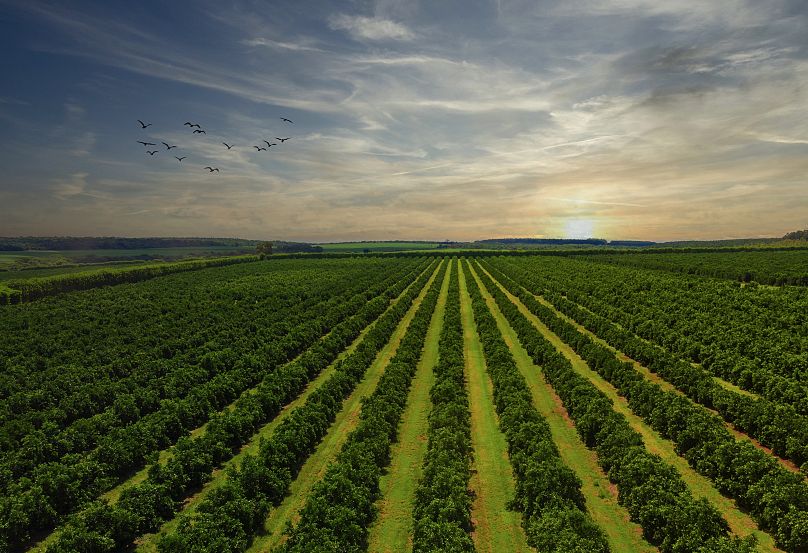Rich in natural resources and renowned for technology and innovation, Brazil is not only self-sufficient in food production, but is one of the world’s leading exporters of soy, cassava, meat, poultry, maize, coffee and oranges.
Agribusiness represents over 20 per cent of the Brazilian GDP and employs a similar percentage of the Brazilian workforce. The terrain from north to south of the country comprises a wide variety of growing conditions, allowing for many types of agriculture and a rich biodiversity. Two thirds of Brazil’s land is covered by native vegetation.
Dogged by historical disregard for environmental preservation, modern Brazilian initiatives are increasingly structured around sustainable development goals. Awareness of the need to preserve the country’s unmatched biodiversity is at the forefront of strategic planning, as is the need to cut greenhouse gas emissions, and Brazil leads the subcontinent in renewable energy.
Technological advances for a greener future
Food security is not a new challenge, and research institution Embrapa (Empresa Brasileira de Pesquisa Agropecuária, Brazilian Agricultural Research Corporation) was created as a Ministry of Agriculture initiative to address the issue almost 50 years ago.
Its stated aim is to “create research, development and innovation solutions to ensure the sustainability of agriculture, for the benefit of Brazilian society,” focusing not only on food production and scientific excellence, but on reducing social and economic inequalities.
Since detailed records of Embrapa’s projects began in 2003, around 1.7 million jobs have been created, and food production continues to show positive growth. From 1975 to 2019, for example, grain production increased by 510 per cent, from 38.1 million tons to 232.6 million tons.
The increase in meat production was even more dramatic. In the same period, it rose from 2.9 million tons to 27.9 million tons, a leap of 858 per cent. Brazil’s annual cattle supply outstrips even that of the United States.
One of Embrapa’s major concerns is finding ways to meet increased demand, both internally and externally, while protecting the environment. Agriculture plays an increasingly strategic role in the economy, as the production of biomass becomes ever more urgent as a source for renewable energy.
At the same time, Brazil’s own natural resources require careful safeguarding, and one of Embrapa’s roles is to raise awareness of good agriculture practices, encouraging rural producers to help combat erosion and recover degraded soil, while respecting biodiversity.
Training and technology are needed to put these principles into practice, and millions of dollars are invested in transforming agriculture at a grassroots level. In order to meet growing international demand for soy, for example, Embrapa promoted the use of the Azospirillum bacterium to inoculate soybeans against disease. The resulting increase in productivity provided an additional profit of almost half a billion US dollars.
In another such programme, Embrapa worked with NGOs, communities and rural producers to improve dairy production. Until the ‘Full Bucket’ programme launched in 2017, Brazilian milk productivity was low, averaging around four litres a day per dairy cow (as against a world average of 10). As a result of the scheme, many farmers saw their yield increase tenfold.
To achieve these goals – greater productivity, sustainable models, environmental protection and a more equal society – the state collaborates with a variety of companies from the private sector.
One such is InCeres, which develops software for soil fertility management and plant nutrition. InCeres aims to put technology and data in the hands of those who most need it: farmers on low incomes, whose productivity is not hitting its potential.
InCeres’ software helps farmers all the way through the production process, starting with soil analysis and planning. The Coleta Agile app then helps with mapping fertility and productivity, using satellite images, and can also monitor pests and disease.
Smart technology communicates with machines in the field to control the application of fertiliser and other nutrients, a goal it shares with Embrapa. Brazil is the fourth largest user of fertiliser in the world, but the war in Ukraine has created problems in the fertiliser supply chain. The need for efficient fertiliser application, using minimum quantities for maximum returns, has never been greater.
With this in mind, Embrapa has created ‘FertBrasil’, a technical support caravan for rural producers. By providing soil analysis to find the most beneficial solutions to unique conditions, the corporation hopes to increase fertiliser efficiency by 10 per cent, saving US1 billion on next year’s crops.
The gains from this are threefold: more efficient use of nutrients not only saves money and brings about a reduced dependency on imports, but pushes Brazil further along its path of sustainable development.


